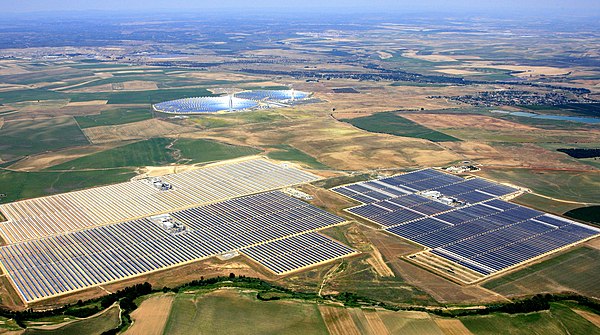
Foto a%C3%A9re de solnovas y torre junio 2010.
(Image by Wikipedia (commons.wikimedia.org), Author: Abengoa Solar) Details Source DMCA
by Katie Singer
For decades, I believed that "green" technologies could make our society sustainable. Then, I began reading about their energy and water use and toxic waste. I realized that 1) I don't know how to live without electricity or computers for more than a few days. 2) I want to reduce my ecological impacts, and I don't know how.
I read economist Herman Daly's principles: Don't take from the Earth faster than it can replenish; and don't waste faster than the Earth can absorb. My mind spun: How can I help reduce environmental impacts internationally--or even locally? How can I reduce dependence on international supply chains? Do I want an energy-resilient country--or just lower electric bills? In this society, how/could I live by Daly's principles?
I challenged myself to investigate my assumptions about "green" technologies. In this article, I'll introduce what I've learned about solar photovoltaics (PVs).
Manufacturing realities
Accurate assessment of any product, including solar PVs, requires analyzing impacts from manufacturing, operation and discard. To begin, manufacturing energy accounts for much more than what any product uses during operation and discard. For example, a laptop consumes 81% of lifetime energy use before its end-user turns it on for the first time.1Then, energy efficiency actually increases consumption: when a product's efficiency increases, its price decreases, and more people buy it. This leads to more manufacturing--more energy use, mining and hazardous waste.2
#1 Manufacturing: Under the glass
You know those white squares under solar panels' glass? They're made from pure silicon, which is not available in nature. Manufacturing polysilicon starts with transporting pure quartz gravel, a pure carbon (i.e., petroleum coke), and moist wood to a smelter that is kept at 3000 degrees Fahrenheit for years at a time. Smelters require steady delivery of electricity--or they could explode. They're typically powered by natural gas, coal and/or nuclear power. Neither solar nor wind can power a smelter since they provide only intermittent power.3
For Step 2, producing polysilicon, a modern factory consumes up to 400 megawatts of continuous power per year. Producing 20,000 tons of polysilicon draws enough power for 300,000 homes.4
Next--making a cylindrical silicon ingot, then slicing it into wafers--are also energy-intensive, toxic waste-emitting processes.5
Nearly half the world's polysilicon comes from a handful of Chinese factories. Reports claim that these manufacturers use forced Uyghur labor.6,7
Once silicon is formed, phosphorous, boron and sometimes arsenic are "doped" into it so wafers can receive electric signals.
To increase durability, dirt-repellency and energy production, a solar panel's frame, front sheet, back sheet and encapsulant8-12 (and batteries, if there are any13,14) each, typically, hold perfluorinated chemicals (PFAs). Exposure to "forever chemicals" may weaken immune systems, increase cholesterol levels, change liver enzymes, increase pregnant women's risks of high blood pressure, and increase kidney or testicular cancer risks.15-17 While manufacturers claim that newer PFAS are safer, research shows that these chemicals are equally harmful.18 If panels crack (from hailstorms, say), do PFAs leach into groundwater?19,20
Transporting solar PVs' raw materials to factories--and final products to consumers--requires cargo ships powered by highly polluting bunker fuel. 21
(Note: You can view every article as one long page if you sign up as an Advocate Member, or higher).





